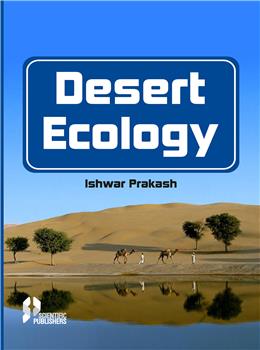Desert Ecology

- ISBN
- Book Format
- Binding
- Language
- Edition
- Imprint
- ©Year
- Pages
- Size (Inch)
- Weight
| Select | Format | INR(₹) |
|---|---|---|
| Print Book | 2,500.00 |

| Select | Format | INR(₹) |
|---|---|---|
| Print Book | 2,500.00 |
It was indeed a happy occasion when the National Academy of Sciences and the University of Rajasthan decided to pool their intellectual and material resources for organizing a National Symposium on Desert Ecology in Jaipur during October 24-27, 1986. The choice of the theme for this symposium was most appropriate, “conquest of the desert” or “combating desertification” being enormously challenging tasks, particularly in view of the steep growth rates of both human and livestock population in the Thar desert. The ever-increasing demands on this scarcity stricken arid land for resources for the sustenance of life have been stressing the desert ecosystem beyond its limit of resilience. And then, when drought strikes here — as it does almost every 3 years — famine stalks the land, bringing untold miseries to man and his beasts alike. Ecologists believe that we are fast approaching the point of no return when the productivity of the desert biome in Rajasthan, even in good rainfall years, will be far below its potentiality. And, as the human and livestock pressure on the land increases, the desertification process would intensify. The potentially disastrous end-result of this web of man-animal-environment interactions warrants thorough and pragmatic analysis by experts drawn from various disciplines. The National Symposium proved to be a good forum for this purpose. Hopefully, the Proceedings of the Symposium will be of use to planners, scientists and technocrats in formulating integrated regional development schemes for the desert tract.
Foreword
Editorial
List of Contributors
1. Ecological degradation of the Thar desert and cco-regeneration
2. Flux in the Indian arid zone
3. Man and the desert
4. Moisture regime variation and agricultural productivity; in Rajasthan
5. Floral wealth and plant adaptation of the Indian desert
6. Adaptations of arid zone plants to soil water deficit
7. Role of wild legumes Indigofera hochstezteri Baker and Zornea gibbosa Span
in enriching the soil with nitrogen
8. Present status and future prospects of horticulture in arid zone
9. Ecology of insect pests of xeric environment
10. Wildlife, human-animal interactions, and conserva- tion in the.Rajasthan desert
11. Livestock population and ecological implications of overgrazing
12. Detection and monitoring" of desertification using remotely sensed data products
13. Salinity control and irrigated agriculture
14. Canal irrigation in arid zone of Rajasthan and its ecological implications
15. Irrigation and human settlements in Sri Ganganagar district
16 Greening the desert
17. Landscape design with special reference to the arid zones
18. Renewable energy potential in arid areas of Raj- asthan
19. Futuie of the Indian desert

SCIENTIFIC PUBLISHERS
"Granthlok"
5-A,Pali Road,
Bhagat Ki Kothi (Near Riktiya Bheruji Circle)
Jodhpur, Rajasthan
PIN - 342 001, INDIA
WhatsApp: +91-77339-04904
Enquiry: +91-95211-31111
Orders: +91-99292-72222
Publishing
Books: +91-97999-91782
Journals: +91-98299-89666
Tel: +91-291-2433323
DELHI
"Granthlok"
4806/24, Ansari Road, Bharat Ram Road, Darya Ganj New Delhi 110002 INDIA
Tel: +91-11-47590696
Email: info@scientificpub.com
Make sure you dont miss interesting happenings
by joining our newsletter program

Government e Marketplace (GeM) is a 100 percent Government owned & National Public Procurement Portal.GeM is dedicated e market for different goods.

© 2025 SCIENTIFIC PUBLISHERS | All rights reserved.